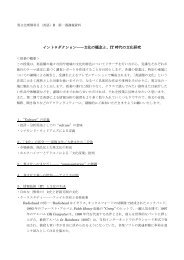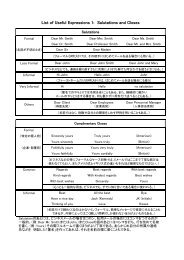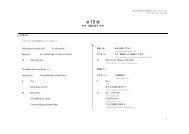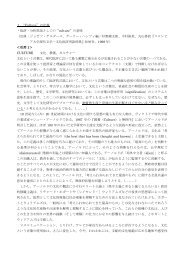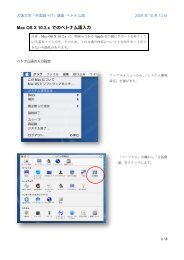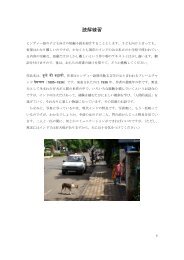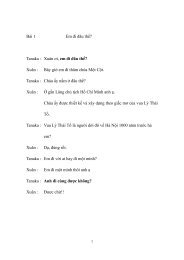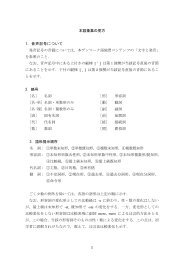4 - 大阪大学世界言語eラーニングサーバ
4 - 大阪大学世界言語eラーニングサーバ
4 - 大阪大学世界言語eラーニングサーバ
You also want an ePaper? Increase the reach of your titles
YUMPU automatically turns print PDFs into web optimized ePapers that Google loves.
資 料 3<br />
D. American Black English<br />
It goes by several names, all of them problematic: Black English, Black Vernacular, African<br />
American English (AAE) and African American Vernacular English (AAVE), to mention a few. In the<br />
mid-1990s the term Ebonics (a blend of “ebony” and “phonics”) lurched to sudden fame after the<br />
Oakland Unified School Board passed a well-meaning but misguided resolution declaring Ebonics to<br />
be the “predominantly primary” language of black children. Many of those children floundered in<br />
school, where teachers scorned their accents and their speaking habits. But instead of focusing on<br />
practical ways to improve the teaching or to boost inner-city kids’ chances in the classroom, the<br />
creators of the Oakland resolution announced that Ebonics was no kind of English—not even, they<br />
said, any kind of Indo-European language—but rather a “genetically based” member of the “West<br />
and Niger-Congo African Language Systems.” If they wanted to make their cause look intellectually<br />
ridiculous, they could hardly have made a better job of it.<br />
In fact, the informal English spoken on occasion by most black Americans is closely related to the<br />
dialect of southern whites. The lengthening of short vowels, a reliance on double negatives, some<br />
systematic changes in verb forms—all these are qualities of white speech in states like Alabama and<br />
South Carolina and of black speech across the United States. Given the cruelties of history, the<br />
resemblance may appear ironic. But it should not be surprising, given that both dialects emerged<br />
from the same principal source: the nonstandard English that belonged to the Scots, Welsh, Irish and<br />
emigrants from rural England in the seventeenth and eighteenth centuries. There were the colonists<br />
who had the greatest contact with newly arrived African slaves, sometimes overseeing their labor,<br />
sometimes working beside them in fields and plantations. These were the people whose voices most<br />
strongly influenced the slaves as they embarked on the painful task of becoming English-speakers.<br />
(Abley 146-147)<br />
E. The Southern drawl<br />
The phonological feature most associated with Southern English is the so-called “southern drawl.”<br />
This is realized by the prolongation of certain vowel sounds and the “breaking of vowels and<br />
diphthongs into triphthongs.” For example, “there” can be pronounced /ðajæ/ and “bad” /bæeɛd/.<br />
Upgliding diphthongs occur in “pass,” “bath” and “after” to give the vowel sound /æɛ/ or /æy/.<br />
Another distinctive characteristic of Southern English is the merging of the vowel sounds /I/ and /e/<br />
as in the words “pin” and “pen.” This distinctive southern drawl excites prejudice in some people, as<br />
illustrated in the following quotes. . . . The first demonstrates the speaker’s surprise that someone<br />
who spoke with a southern drawl might be intelligent and the second. . . that a highly educated<br />
person—a one-time President of the United States—could speak with a southern drawl:<br />
“. . . Beneath that deceptive North Carolina drawl, there’s a crisp intelligence.”<br />
“Governor Clinton, you attended Oxford University in England and Yale Law School in the Ivy



